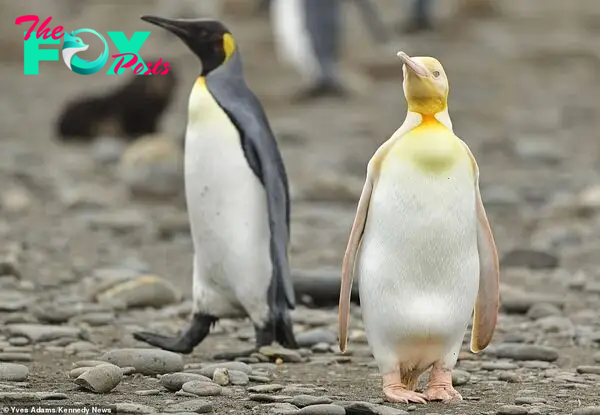Mysterious
LS ŌĆØImages of an incredibly rare yellow penguin photographed with a group of 120,000 other king penguins between Antarctica and Africa. The penguin has a condition that causes lighter pigmentation, causing it to be yellow and white.ŌüĀ ŌĆØ

(Image credit: Kennedy News and Media/Yves Adams)
Black-and-white tuxedos may be the conventional dress code in the penguin world, but one dashing individual is breaking the status quo with an ├Ā la mode yellow coat.
A wildlife photographer captured images of the rare┬Āpenguin┬Āon a remote island in South Georgia in December 2019 and only recently released the photos. A king penguin ŌĆ£walked up straight to our direction in the middle of a chaos full of sea elephants and Antarctic fur seals, and thousands of other king penguins,ŌĆØ the photographer from Belgium, Yves Adams┬Āwrote on an Instagram post. ŌĆ£How lucky could I be!ŌĆØ

At the time, Adams was leading a two-month photography expedition through the South Atlantic and had stopped on a South Georgia beach. While unpacking safety equipment, he saw a fluttering of penguins swimming toward the shore ŌĆö one individual immediately caught his eye.
ŌĆ£IŌĆÖd never seen or heard of a yellow penguin before. There were 120,000 birds on that beach, and this was the only yellow one there,ŌĆØ Adams told Kennedy News and Media. ŌĆ£We all went crazy when we realized. We dropped all the safety equipment and grabbed our cameras.ŌĆØ
King penguins (Aptenodytes patagonicus), just like the closely related emperor penguins (Aptenodytes forsteri), typically adorn a black-and-white coat with a yellowish-gold dash of color on their collar. The yellow pigments are ŌĆ£unique to penguins,ŌĆØ though not all species have them,┬Āaccording to the Australian Antarctic Program.

This particular penguin seems to have retained its yellow feathers but lost its dark ones, which are typically colored by a blackish brown pigment known as melanin.
Penguins with unusual plumage are relatively rare, and sometimes it can be difficult to identify the cause behind the rare colors just by looking at the penguins, according to the Australian Antarctic Program. Some unusual coloring can be due to injury, diet or disease, but many instances are due to mutations in the birdŌĆÖs┬Āgenes. Such mutations can cause, for example, ŌĆ£melanisticŌĆØ penguins whose typically white parts are black and ŌĆ£albinisticŌĆØ penguins that donŌĆÖt have any melanin and thus are white.

The yellow penguin lost its melanin, a pigment that colors some of its feathers black.┬Ā(Image credit: Kennedy News and Media/Yves Adams)
Adams told Kennedy News that the yellow bird has a genetic condition known as leucism in which only some of the melanin is lost.
Dee Boersma, a conservation biologist and professor at the University of Washington who was not a part of the expedition, agreed. ŌĆ£This penguin is lacking some pigment so it is [leucistic],ŌĆØ Boersma told Live Science in an email. ŌĆ£True albinos have lost all pigment.ŌĆØ (Boersma said the bird has a brown head and so must have retained some of the pigment.)
Still, others disagree.

ŌĆ£I wouldnŌĆÖt call the bird leucistic,ŌĆØ because the penguin seems to lack all melanin, said Kevin McGraw, an integrative behavioral ecologist at Arizona State University, who also wasnŌĆÖt part of the expedition.
ŌĆ£It does look albino from the perspective that it lacks all melaninŌĆØ in its plumage, feet and eyes, McGraw said. Still, ŌĆ£weŌĆÖd need feather samples for biochemical testing if we aimed to unequivocally document,ŌĆØ whether melanin is present, he said.
Animals can be albino but still have non-melanin pigment, he added.
The penguin has lost the carotenoid or yellow-orange-red pigment in its beak and the melanin pigment in its feathers, while retaining the yellow pigment in its feathers. So the genetic and cellular machinery for some pigments were knocked out whereas others were not. ŌĆ£IŌĆÖm not aware of many other images or birds like this,ŌĆØ McGraw said. ŌĆ£IŌĆÖve been fascinated by this photo.ŌĆØ
Such oddly colored birds are rare ŌĆö and likely for a reason.
Penguins use body and plumage color for a variety of functions, including mate selection, camouflage or┬Āprotection from the sun, McGraw said. ŌĆ£ItŌĆÖs conceivable that such color aberrations could impact both survival and reproduction.ŌĆØ
The team was lucky that the yellow penguin landed close enough that they were able to ŌĆ£get this show of a lifetime,ŌĆØ Adams said. ŌĆ£Our view wasnŌĆÖt blocked by a sea of massive animals. Normally, itŌĆÖs almost impossible to move on this beach because of them all.ŌĆØ
Related Posts
-

 Mysterious4m ago
Mysterious4m agoSA..The Astonishing and Terrifying Experience of Coming Face to Face with a 4-Meter Octopus!..SA
-

 Mysterious4m ago
Mysterious4m agonht.ŌĆØExploring HumanityŌĆÖs Pursuit of the Legendary 9-Meter, 4-Ton Giant.ŌĆØ
-

 Mysterious4m ago
Mysterious4m agonht.Once-In-A-Lifetime Footage Of A Massive Humpback Whale Leaping Out Of The Water Next To A Fishing Boat
-

 Mysterious4m ago
Mysterious4m ago.Global Sensation: Mesmerizing Footage of Giant Prehistoric Swordfish Captivates Audiences..D
-

 Mysterious4m ago
Mysterious4m agonht.The discovery of a peculiar creature with human and fish-like features is causing a stir on social media.
-

 Mysterious4m ago
Mysterious4m agonht.Google Maps reveals a possible extraterrestrial portal near Area 51, sparking widespread interest in the UFO community.
-

 Mysterious4m ago
Mysterious4m ago.Heroic Act: Rescuing Live Turtles from Fish Markets and Returning Them to the Ocean..D
-

 Mysterious4m ago
Mysterious4m agoB83.Exploring the Universe: Alien Forms and Their Extraordinary Means of Transportation Revealed

























